Hyundai Tucson: Engine And Transaxle Assembly / Engine And Transaxle Assembly Repair procedures
| • |
Use fender covers to avoid damaging painted surfaces. |
| • |
To avoid damage, unplug the wiring connectors carefully while holding the connector portion. |
|
| • |
Mark all wiring and hoses to avoid misconnection. |
| • |
To release the fuel system pressure before removing the
engine assembly, start the engine with the fuel pump relay removed. And
then turn off the ignition switch after engine stops. |
|
| 1. |
Remove the engine cover (A). 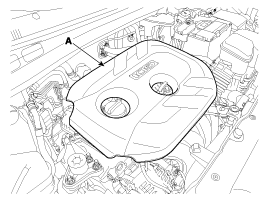
| • |
To avoid damage, remove the engine cover on room temperature. |
| • |
To avoid damage of the engine cover, do not disengage both front and rear mounting point at the same time. |
|
|
| 2. |
Disconnect the battery terminals (A). The negative terminal first.
Tightening torque
(+) terminal:
7.8 ~ 9.8 N.m (0.8 ~ 1.0 kgf.m, 5.8 ~ 7.2 lb-ft)
(-) terminal:
3.9 ~ 5.9 N.m (0.4 ~ 0.6 kgf.m, 3.0 ~ 4.4 lb-ft)
|
|
| 3. |
Remove the air cleaner assembly.
| (1) |
Remove the air duct (B).
Tightening torque :
7.8 ~ 9.8 N.m (0.8 ~ 1.0 kgf.m, 5.8 ~ 7.2 lb-ft)
|
|
| (2) |
Disconnect the breather hose ( C). |
| (3) |
Disconnect the air intake hose (D) and then remove the air cleaner assembly (E).
Tightening torque
Hose clamp bolt:
2.9 ~ 4.9 N.m (0.3 ~ 0.5 kgf.m, 2.2 ~ 3.6 lb-ft)
Air cleaner assembly bolts:
7.8 ~ 9.8 N.m (0.8 ~ 1.0 kgf.m, 5.8 ~ 7.2 lb-ft)
|
|
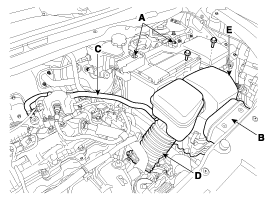
| • |
Install the air intake hose while the plate of the hose clamp must be in line with the stopper of the hose. |
| • |
Install the air intake hose while the center of the mark of hose must be in line with the throttle body rib. |
|
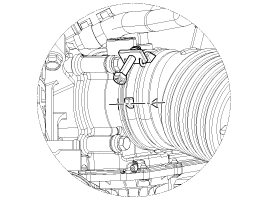
|
| 4. |
Remove the battery (A) after removing the mounting bracket (B).
Tightening torque:
9.8 ~ 14.7 N.m (1.0 ~ 1.5 kgf.m, 7.2 ~ 10.8 lb-ft)
|
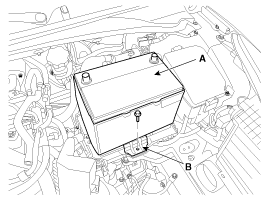
|
| 5. |
Disconnect the ECM connectors (A) and remove the ECM (B).
Tightening torque:
9.8 ~ 11.8 N.m (1.0 ~ 1.2 kgf.m, 7.2 ~ 8.7 lb-ft)
|
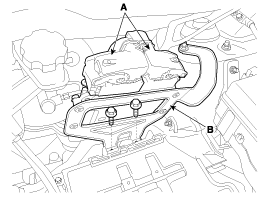
|
| 6. |
Loosen the battery “+” cable bracket mounting bolt (A) and then remove the battery tray (B).
Tightening torque:
9.8 ~ 14.7 N.m (1.0 ~ 1.5 kgf.m, 7.2 ~ 10.8 lb-ft)
|
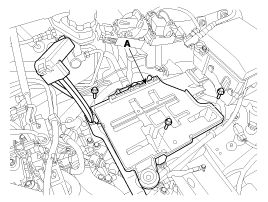
|
| 7. |
Remove the under cover (A).
Tightening torque:
7.8 ~ 11.8N.m (0.8 ~ 1.2kgf.m, 5.8 ~ 8.7lb-ft)
|
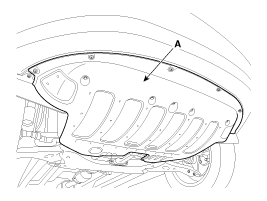
|
| 8. |
Loosen the drain plug, and drain the engine coolant. Remove the radiator cap to help drain the coolant faster.
(Refer to Cooling system in this group) |
| 9. |
Disconnect the radiator upper hose (A). 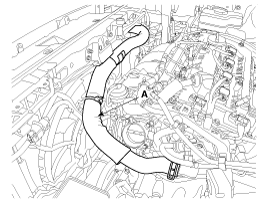
|
| 10. |
Disconnect the radiator lower hose (A). 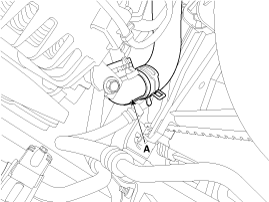
|
| 11. |
Recover the refrigerant and then remove the high pressure pipe and the low pressure pipe (A).
(Refer to Heating,Ventilation, Air Conditioning - "Air Conditioning System") 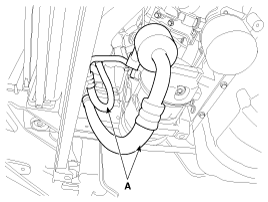
|
| 12. |
Remove the transaxle wire harness connectors, control cable and hoses from the transaxle.
(Refer to Manual Transaxle System)
(Refer to Automatic Transaxle System) |
| 13. |
Disconnect the heater hoses (A). 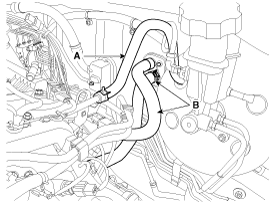
|
When installing the heater hoses, install as shown in illustrations. |
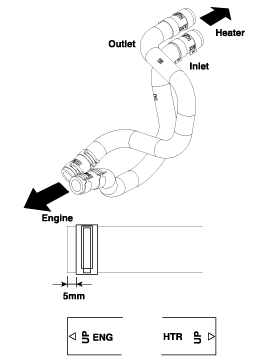
|
| 14. |
Disconnect the wiring connectors and harness clamps, and then
remove the wiring and protectors from the cylinder head and the intake
manifold.
| (1) |
The intake OCV (Oil control valve) connector (A) 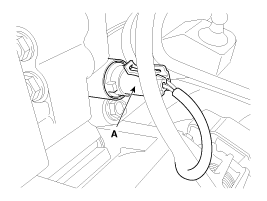
|
| (2) |
The exhaust OCV (Oil control valve) connector (A) 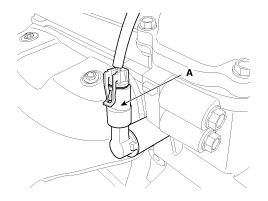
|
| (3) |
The alternator connector (A) 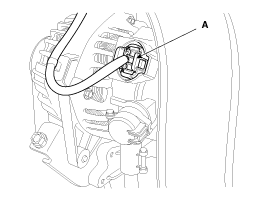
|
| (4) |
The ignition coil connectors (A), fuel pump connector(B). 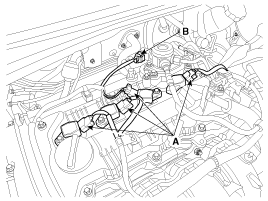
|
| (5) |
The intake CMPS (Camshaft position sensor) connector (A) |
| (6) |
The exhaust CMPS (Camshaft position sensor) connector (B) 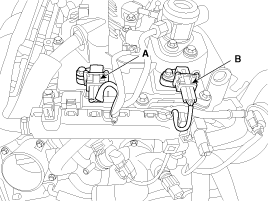
|
| (7) |
The injector connectors (A) 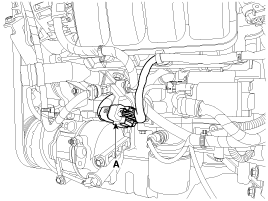
|
| (8) |
The front and/or rear HO2S (Heated oxygen sensor connectors) (A) 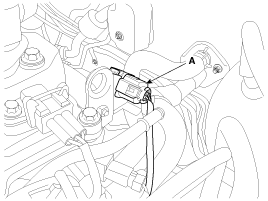
|
| (9) |
The condenser connector (A) 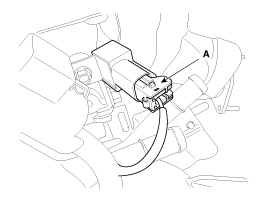
|
| (10) |
The PCSV (Purge control solenoid valve) connector (A) 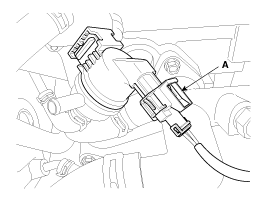
|
| (11) |
The ECTS (Engine coolant temperature sensor) connector (A) 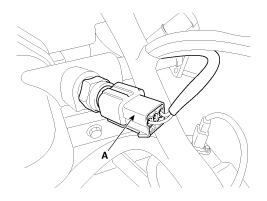
|
| (12) |
The VIS (Variable Intake System) connector (A) 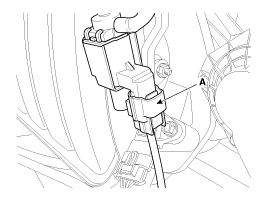
|
| (13) |
The MAPS (Manifold absolute pressure sensor) & IATS (Intake air temperature sensor) connector (A) 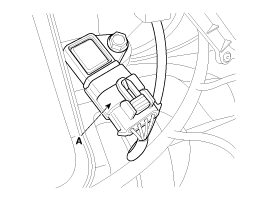
|
| (14) |
The ETC (Electronic throttle control) connector (A) 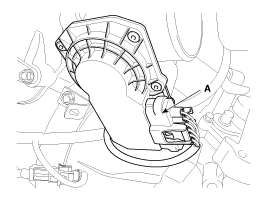
|
|
| 15. |
Disconnect the "+" cable (A) and the front connector (B). 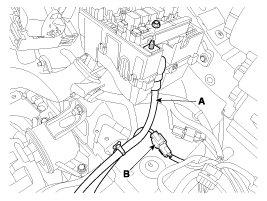
|
| 16. |
Disconnect the fuel hose (A) and the PCSV (Purge control solenoid valve) hose (B). 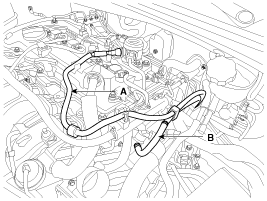
|
| 17. |
Remove the front muffler ( A).
Tightening torque:
39.2 ~ 58.8 N.m (4.0 ~ 6.0 kgf.m, 28.9 ~ 43.4 lb-ft)
|
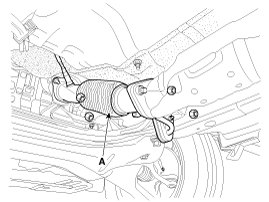
|
| 18. |
Remove the steering u-joint mounting bolt (A).
(Refer to Steering System - “Steering Gear Box”) 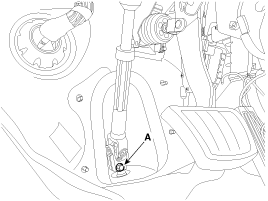
|
| 19. |
Remove the front wheels.
(Refer to Suspension System) |
| 20. |
Remove the lower arms (A).
(Refer to Suspension System - “Front Lower Arm”) 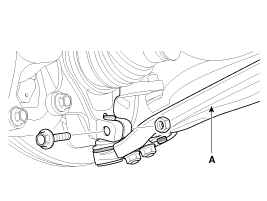
|
| 21. |
Remove the stabilizer bar links (A).
(Refer to Suspension System - “Front Stabilizer Bar”) 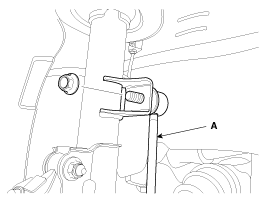
|
| 22. |
Remove the tie rod ends (A).
(Refer to Steering System - “Steering Gear Box”) 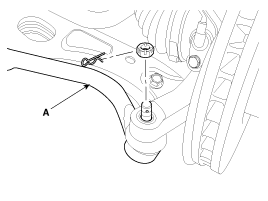
|
| 23. |
Disconnect the drive shafts (A) from the axle hubs.
(Refer to Driveshaft and axle - “Front Driveshaft”) 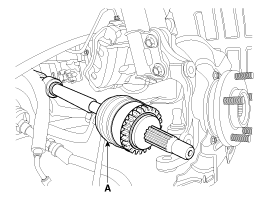
|
| 24. |
Remove the roll rod bracket (A).
Tightening torque
Nut (B):
107.9 ~ 127.5 N.m (11.0 ~ 13.0 kgf.m, 79.6 ~ 94.0 lb-ft)
Bolt (C):
49.0 ~ 63.7 N.m (5.0 ~ 6.5 kgf.m, 36.2 ~ 47.0 lb-ft)
|
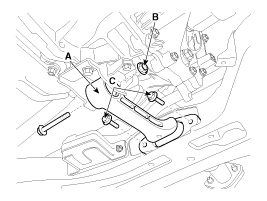
|
| 25. |
Remove the roll rod mounting support bracket (A).
Tightening torque:
49.0 ~ 68.6 N.m (5.0 ~ 7.0 kgf.m, 36.2 ~ 50.6 lb-ft)
|
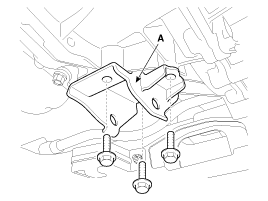
|
| 26. |
Support the sub frame (A) with a floor jack, and then remove the sub frame mounting bolts and nuts.
Tightening torque
Sub frame mounting bolts & nuts:
176.5 ~ 196.7 N.m (18.0 ~ 20.0 kgf.m, 130.2 ~ 144.7 lb-ft)
|
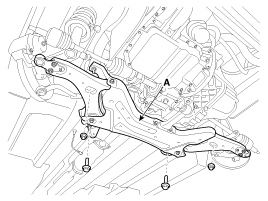
| • |
After removing the sub frame mounting bolts and nuts, the
engine and transaxle assembly may fall down, so support them securely
with floor jack. |
| • |
Verify that the hoses and connectors are disconnected before removing the engine and transaxle assembly. |
|
|
| 27. |
Disconnect the ground line (A), and then remove the engine mounting support bracket (B).
Tightening torque
Ground line bolt (A):
10.8 ~ 13.7 N.m (1.1 ~ 1.4 kgf.m, 8.0 ~ 10.1 lb-ft)
Nut (C):
78.5 ~ 98.1 N.m (8.0 ~ 10.0 kgf.m, 57.9 ~ 72.3 lb-ft)
Bolt (D) and nuts (E):
78.5 ~ 98.1 N.m (8.0 ~ 10.0 kgf.m, 57.9 ~ 72.3 lb-ft)
|
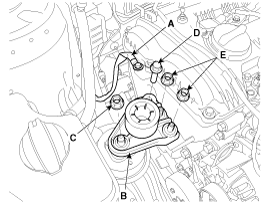
|
| 28. |
Disconnect the ground line (A). 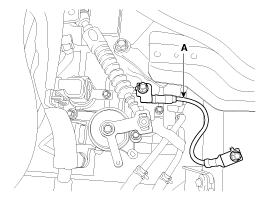
|
| 29. |
Remove the service cover (A). 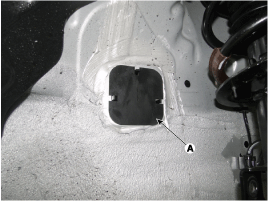
|
| 30. |
Remove the transaxle mounting bracket bolt (A).
Tightening torque:
88.3 ~ 107.9 N.m (9.0 ~ 11.0 kgf.m, 65.1 ~ 79.6 lb-ft)
|
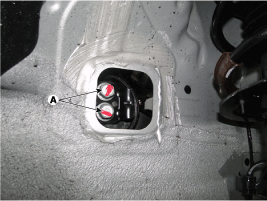
|
| 31. |
Lower the engine and transaxle assembly (A) using a floor
jack and then remove the engine and transaxle assembly by lifting
vehicle. 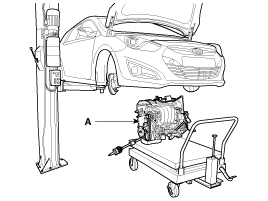
|
When remove the engine and transaxle assembly, be careful not to damage any surrounding parts or body components. |
|
Installation is in the reverse order of removal.
|
Perform the following:
| • |
Refill engine with engine oil. |
| • |
Refill a transaxle with fluid. |
| • |
Refill a radiator and a reservoir tank with engine coolant. |
| • |
Clean battery posts and cable terminals and assemble. |
| • |
Inspect for fuel leakage. |
| - |
After assembling the fuel line, turn on the ignition switch
(do not operate the starter) so that the fuel pump runs for
approximately two seconds and fuel line pressurizes. |
| - |
Repeat this operation two or three times, then check for fuel leakage at any point in the fuel line. |
| • |
Bleed air from the cooling system. |
| - |
Start engine and let it run until it warms up (until the radiator fan operates 3 or 4 times). |
| - |
Turn off the engine. Check the level in the radiator, add
coolant if needed. This will allow trapped air to be removed from the
cooling system. |
| - |
Put radiator cap on tightly, then run the engine again and check for leaks. |
|
Components
1. Engine mounting bracket2. Transaxle mounting bracket3. Roll rod bracket
...
Other information:
Hyundai Tucson (LM) 2010-2015 Owners Manual: Automatic transaxle operation
The automatic transaxle has six forward speeds and one reverse speed.
The individual speeds are selected automatically in the D (Drive) position.
WARNING
To reduce the risk of serious injury or death:
ALWAYS check the surrounding areas near your vehicle for people, especially
children, bef ...
Hyundai Tucson (LM) 2010-2015 Service Manual: Repair procedures
Refrigerant System Service Basics
Refrigerant Recovery
Use only service equipment that is U.L-listed and is
certified to meet the requirements of SAE J2210 to remove
HFC-134a(R-134a) from the air conditioning system.
-
Air conditioning refrigerant or lubricant vapor ...
 Engine Mounting Components and Components Location
Engine Mounting Components and Components Location Timing System
Timing System










































